new posts in all blogs
Viewing: Blog Posts Tagged with: picture book poetry, Most Recent at Top [Help]
Results 1 - 14 of 14
How to use this Page
You are viewing the most recent posts tagged with the words: picture book poetry in the JacketFlap blog reader. What is a tag? Think of a tag as a keyword or category label. Tags can both help you find posts on JacketFlap.com as well as provide an easy way for you to "remember" and classify posts for later recall. Try adding a tag yourself by clicking "Add a tag" below a post's header. Scroll down through the list of Recent Posts in the left column and click on a post title that sounds interesting. You can view all posts from a specific blog by clicking the Blog name in the right column, or you can click a 'More Posts from this Blog' link in any individual post.
 Fun Fact: The American Library Association does not currently give an award specifically to great works of children’s book poetry. Is not that strange? When I first discovered this to be true, I was perplexed. I’ve always been a bit of a rube when it comes to the poetic form. Placing stresses on syllables and knowing what constitutes a sestina and all that. Of course even without its own award specifically, poetry can win the Newbery or the Caldecott. Yet too often when it happens it’s in the form of a verse novel or its sort of pooh-poohed for its win. Remember when Last Stop on Market Street won the Newbery and folks were arguing that it was the first picture book to do so since A Visit to William’s Blake’s Inn couldn’t possibly be considered a picture book because it was poetry? None of this is to say that poetry doesn’t win Newberys (as recently as 2011 Dark Emperor and Other Poems of the Night by Joyce Sidman won an Honor) but aside from the month of April (Poetry Month a.k.a. the only time the 811 section of the public library is sucked dry) poetry doesn’t get a lot of attention.
Fun Fact: The American Library Association does not currently give an award specifically to great works of children’s book poetry. Is not that strange? When I first discovered this to be true, I was perplexed. I’ve always been a bit of a rube when it comes to the poetic form. Placing stresses on syllables and knowing what constitutes a sestina and all that. Of course even without its own award specifically, poetry can win the Newbery or the Caldecott. Yet too often when it happens it’s in the form of a verse novel or its sort of pooh-poohed for its win. Remember when Last Stop on Market Street won the Newbery and folks were arguing that it was the first picture book to do so since A Visit to William’s Blake’s Inn couldn’t possibly be considered a picture book because it was poetry? None of this is to say that poetry doesn’t win Newberys (as recently as 2011 Dark Emperor and Other Poems of the Night by Joyce Sidman won an Honor) but aside from the month of April (Poetry Month a.k.a. the only time the 811 section of the public library is sucked dry) poetry doesn’t get a lot of attention.
So rather than relegate all poetry discussions to April, let us today celebrate some of the lovelier works of poetry out for kids this year. Because we lucked out, folks. 2016 was a great year for verse:
2016 Poetry Books for Kids
Are You an Echo?: The Lost Poetry of Misuzu Kaneko by David Jacobson, ill. Toshikado Hajiri, translations by Sally Ito and Michiko Tsuboi

No surprises here. If you know me then you know I’m gaga for this title. For the purposes of today’s list, however, let’s just zero in on Kaneko’s own poetry. Cynical beast that I am, I would sooner eat my own tongue than use a tired phrase like “childlike wonder” to describe something. And yet . . . I’m stuck. Honestly there’s no other way to adequately convey to you what Kaneko has done so perfectly with this book. Come for the biography and history lesson. Stay for the incomparable poems.
Freedom Over Me: Eleven Slaves, Their Lives and Dreams Brought to Life by Ashley Bryan

I’m not entirely certain that I can express in words how deeply satisfying it’s been to see this book get as much love and attention as it has, so far. Already its appeared on Chicago Public Library’s Best of the Best, its been a Kirkus Prize Finalist, it was on the NCTE Notable Poetry List, and New York Public Library listed it on their Best Books for Kids. I would have liked to add an Image Award nomination in there as well, but you don’t always get what you want. Regardless, I maintain my position that this is a serious Newbery contender. Even if it misses out during the January award season, there is comfort in knowing that folks are finding it. Very satisfying.
Grumbles From the Town: Mother-Goose Voices With a Twist by Jane Yolen and Rebecca Kai Dotlich, ill. Angela Matteson

Its been promoted as a writing prompt book, but I’d argue that the poetry in this collection stands on its own two feet as well. Yolen and Dotlich take classic nursery rhymes and twist them. We’ve all seen that kind of thing before, but I like how they’ve twisted them. A passing familiarity with the original poetry a good idea, though they’ve covered their bases and included that information in the back of the book as well. Good original fun all around.
Jazz Day: The Making of a Famous Photograph by Roxane Orgill, ill. Francis Vallejo

So far it’s won the only major award (aside from the Kirkus prize) to be released so far for a 2016 title. Jazz Day took home the gold when it won in the picture book category of the Boston Globe-Horn Book Awards. And, granted, I was on that committee, but I wasn’t the only one there. It’s such an amazing book, and aside from poetry its hard to slot it into any one category. Fiction or nonfiction? You be the judge.
Miss Muffet, Or What Came After by Marilyn Singer, ill. David Litchfield

It’s sort of epic. From one single short little nursery rhyme, Singer spins out this grandiose tale of crushed hopes, impossible dreams, and overcoming arachnophobia. Since it’s a story told in rhyme I’m sort of cheating, putting it on this poetry list. Maybe it’s more school play than poetry book. I say, why not be both?
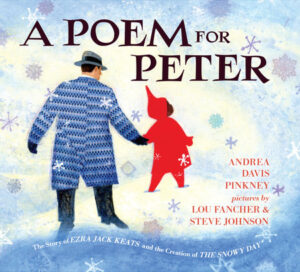
Now this book has been nominated for an NAACP Image Award, so there is some justice in this world. When I first read the description I wasn’t entirely certain how it would work. Imagine the daunting task of telling Ezra Jack Keats’ story using his own illustration style. Imagine too the difficulty that comes with using poetry and verse to tell the details of his story. Pinkney’s done poetry of one sort or another before, but I dare say this is her strongest work to date in that style.
Slickety Quick: Poems About Sharks by Skila Brown, ill. Bob Kolar

From the start I liked the poems (they were smart) but since it was about real sharks I pondered that question every children’s librarian knows so well: how would it fly with kids? Well, I donated a copy to my kid’s daycare and found, to my infinite delight, that the kids in that class were CRAZY about it. Every day when I went to pick my daughter up, she and the other kids would start telling me shark facts. You’ve gotta understand that these were four-year-olds telling me this stuff. If they get such a kick out of the book (and they do) imagine how the older kids might feel!
A Toucan Can, Can You? by Danny Adlerman, ill. Various
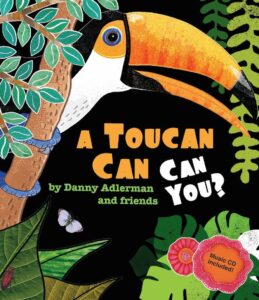
It’s baaaaack. Yeah, this little self-published gem keeps cropping up on my lists. Someone recently asked me where they could purchase it, since it’s not available through the usual streams. I think you can get it here, in case you’re curious. And why should you be curious? Because it takes that old How Much Wood Could a Woodchuck Chuck, expands it, and then gets seriously great illustrators to contribute. A lovely book.
Somo Como Las Nubes / We Are Like the Clouds by Jorge Argueta, ill. Elisa Amado
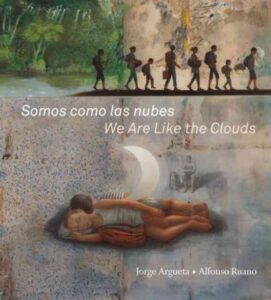
Because to be perfectly frank, your shelves aren’t exactly exploding with books about refugee children from South America. That said, it’s easy to include books on lists of this sort because their intentions are good. It’s another thing entirely when the book itself actually is good. Argueta is an old hand at this. You can trust him to do a fantastic job, and this book is simultaneously necessary and expertly done. There’s a reason I put it on my bilingual book list as well.
Spinach Dip Pancakes by Kevin Kammeraad, ill. Danny Adlerman, Kim Adlerman, Chris Fox, Alynn Guerra, Justin Haveman, Ryan Hipp, Stephanie Kammeraad, Carlos Kammeraad, Maria Kammeraad, Steve Kammeraad, Linda Kammeraad, Laurie Keller, Scott Mack, Ruth McNally Barshaw, Carolyn Stich, Joel Tanis, Corey Van Duinen, Aaron Zenz, & Rachel Zylstra
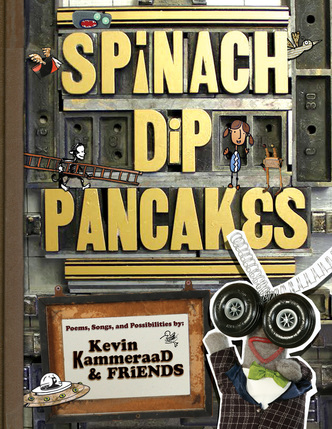
This book bears not a small number of similarities to the aforementioned Toucan Can book. The difference, however, is that these are all original little tiny poems put into a book illustrated by a huge range of different illustrators. The poems are funny and original and the art eclectic, weird, wise and wonderful. It even comes with a CD of performances of the poems. Want a taste? Then I am happy to premiere a video that is accompanying this book. The video cleverly brings to life the poem “Game”. I think you’ll get a kick out of it. And then be unable to remove it from your brain (good earworm, this).
If you liked that, check out the book’s book trailer and behind-the-scenes peek as well.
Wet Cement: A Mix of Concrete Poems by Bob Raczka

My year is not complete unless I am able to work a Raczka poetry collection onto a list. I’m very partial to this one. It’s a bit graphic design-y and a bit clever as all get out. Here’s my favorite poem of the lot:
Poetry is about taking away the words you don’t need
poetry is taking away words you don’t need
poetry is words you need
poetry is words
try
When Green Becomes Tomatoes: Poems for All Seasons by Julie Fogliano, ill. Julie Morstad

I think I broke more than a few hearts when I told people that Morstad’s Canadian status meant the book was ineligible for a Caldecott. At least you can take comfort in the fact that the poetry is sublime. I think we’ve all seen our fair share of seasonal poems. They’re not an original idea, yet Fogliano makes them seem new. This collection actually bears much in common with the poetry of the aforementioned Misuzu Kaneko. I think she would have liked it.
You Can Fly: The Tuskegee Airmen by Carole Boston Weatherford, ill. Jeffery Boston Weatherford
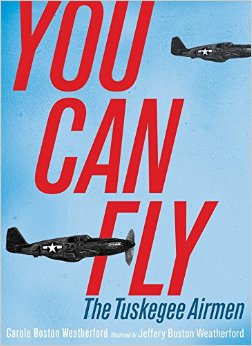
It’s poetry and a kind of verse novel as well. I figured I should include one in today’s list, though I’d argue that the verse here serves the poems better than the storyline. There is a storyline, of course, but I like the poetry for its own sake. My favorite in the book? The one about Lena Horne. I had no idea the personal sacrifices she made during WWII. There’s a picture book bio coming out about her in 2017, by the way. Looks like I’ll need to know more.
Interested in the other lists of the month? Here’s the schedule so that you can keep checking back:
December 1 – Board Books
December 2 – Board Book Adaptations
December 3 – Nursery Rhymes
December 4 – Picture Book Readalouds
December 5 – Rhyming Picture Books
December 6 – Alphabet Books
December 7 – Funny Picture Books
December 8 – Calde-Nots
December 9 – Picture Book Reprints
December 10 – Math Picture Books
December 11 – Bilingual Books
December 12 – International Imports
December 13 – Books with a Message
December 14 – Fabulous Photography
December 15 – Fairy Tales / Folktales
December 16 – Oddest Books of the Year
December 17 – Older Picture Books
December 18 – Easy Books
December 19 – Early Chapter Books
December 20 – Graphic Novels
December 21 – Poetry
December 22 – Fictionalized Nonfiction
December 23 – American History
December 24 – Science & Nature Books
December 25 – Transcendent Holiday Titles
December 26 – Unique Biographies
December 27 – Nonfiction Picture Books
December 28 – Nonfiction Chapter Books
December 29 – Novel Reprints
December 30 – Novels
December 31 – Picture Books


By:
Betsy Bird,
on 6/29/2016
Blog:
A Fuse #8 Production
(
Login to Add to MyJacketFlap)
JacketFlap tags:
picture book poetry,
African-American authors and illustrators,
Best Books of 2016,
2016 reviews,
Reviews 2016,
2016 poetry,
Reviews,
history,
poetry,
Simon and Schuster,
Atheneum,
Best Books,
Ashley Bryan,
multicultural children's literature,
African-American history,
Add a tag
 Freedom Over Me: Eleven slaves, their lives and dreams brought to life
Freedom Over Me: Eleven slaves, their lives and dreams brought to life
By Ashley Bryan
Atheneum (an imprint of Simon & Schuster)
$17.99
ISBN: 978-1481456906
Ages 9 and up
On shelves September 13th
Who gives voice to the voiceless? What are your credentials when you do so? When I was a teen I used to go into antique stores and buy old family photographs from the turn of the century. It still seems odd to me that this is allowed. I’d find the people who looked the most interesting, like they had a story to tell, and I’d take them home with me. Then I’d write something about their story, though mostly I just liked to look at them. There is a strange comfort in looking at the faces of the fashionable dead. A little twinge of momento mori mixed with the knowledge that you yourself are young (possibly) and alive (probably). It’s easy to hypothesize about a life when you can see that person’s face and watch them in their middle class Sunday best. It is far more difficult when you have no face, a hint of a name, and/or maybe just an age. Add to this the idea that the people in question lived through a man made hell-on-earth. When author/illustrator/artist Ashley Bryan acquired a collection of slave-related documents from the 1820s to the 1860s he had in his hands a wealth of untold stories. And when he chose to give these people, swallowed by history, lives and dignity and peace, he did so as only he could. With the light and laughter and beauty that only he could find in the depths of uncommon pain. Freedom Over Me is a work of bravery and sense. A way of dealing with the unimaginable, allowing kids an understanding that there is a brain, heart, and soul behind every body, alive or dead, in human history.
The date on the Fairchilds Appraisement is July 5, 1828. On it you will find a list of goods to be sold. Cows, hogs, cotton . . . and people. Eleven people, if we’re going to be precise (and we are). Most have names. One does not. Just names on a piece of paper almost 200-years-old. So Ashley Bryan, he takes those names and those people, and for the first time in centuries we get to meet them. Here is Athelia, a laundress who once carried the name Adero. On one page we hear about her life. On the next, her dreams. She remembers the village she grew up in, the stories, and the songs. And she is not alone in this. As we meet each person and learn what they do, we get a glimpse into their dreams. We hear their hopes. We wonder about their lives. We see them draw strength from one another. And in the end? The sale page sits there. The final words: “Administered to the best of our Judgment.”
 I have often said, and I say it to this day, that if there were ever a Church of Ashley Bryan, every last person who has ever met him or heard him speak would be a member. There are only a few people on this great green Earth that radiant actual uncut goodness right through their very pores. Mr. Bryan is one of those few, so when I asked at the beginning of this review what the credentials are for giving voice to the voiceless, check off that box. There are other reasons to trust him, though. A project of this sort requires a certain level of respect for the deceased. To attain that, and this may seem obvious, the author has to care. Read enough books written for kids and you get a very clear sense of those books written by folks who do not care vs. folks that do. Even then, caring’s not really enough. The writing needs to be up to speed and the art needs to be on board. And for this particular project, Ashley Bryan had a stiffer task at hand. Okay. You’ve given them full names and backgrounds and histories. What else do they need? Bryan gives these people something intangible. He gives them dreams. It’s right there in the subtitle, actually: “Eleven slaves, their lives and dreams brought to life.”
I have often said, and I say it to this day, that if there were ever a Church of Ashley Bryan, every last person who has ever met him or heard him speak would be a member. There are only a few people on this great green Earth that radiant actual uncut goodness right through their very pores. Mr. Bryan is one of those few, so when I asked at the beginning of this review what the credentials are for giving voice to the voiceless, check off that box. There are other reasons to trust him, though. A project of this sort requires a certain level of respect for the deceased. To attain that, and this may seem obvious, the author has to care. Read enough books written for kids and you get a very clear sense of those books written by folks who do not care vs. folks that do. Even then, caring’s not really enough. The writing needs to be up to speed and the art needs to be on board. And for this particular project, Ashley Bryan had a stiffer task at hand. Okay. You’ve given them full names and backgrounds and histories. What else do they need? Bryan gives these people something intangible. He gives them dreams. It’s right there in the subtitle, actually: “Eleven slaves, their lives and dreams brought to life.”
And so the book is a work of fiction. There is no amount of research that could discover Bacus or Peggy or Dora’s true tales. So when we say that Bryan is giving these people their lives back, we acknowledge that the lives he’s giving them aren’t the exact lives they led. And so we know that each person is a representative above and beyond the names on that page. Hence the occupations. Betty is every gardener. Stephen every architect. Dora every child that was born to a state of slavery and labored under it, perhaps their whole lives. And there is very little backmatter included in this book. Bryan shows the primary documents alongside a transcription of the sales. There is also an Author’s Note. Beyond that, you bring to the book what you already know about slavery, making this a title for a slightly older child readership. Bryan isn’t going to spend these pages telling you every daily injustice of slavery. Kids walk in with that knowledge already in place. What they need now is some humanity.
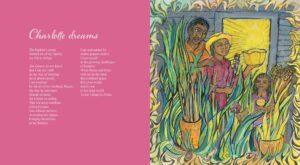 Has Mr. Bryan ever done anything with slavery before? I was curious. I’ve watched Mr. Bryan’s books over the years and they are always interesting. He’s done spirituals as cut paper masterpieces. He’s originated folktales as lively and quick as their inspirational forbears. He makes puppets out of found objects that carry with them a feeling not just of dignity, but pride. But has he ever directly done a book that references slavery? So I examined his entire repertoire, from the moment he illustrated Black Boy by Richard Wright to Susan Cooper’s Jethro and the Jumbie to Ashley Bryan’s African Folktales, Uh-Huh and beyond. His interest in Africa and song and poetry knows no bounds, but never has he engaged so directly with slavery itself.
Has Mr. Bryan ever done anything with slavery before? I was curious. I’ve watched Mr. Bryan’s books over the years and they are always interesting. He’s done spirituals as cut paper masterpieces. He’s originated folktales as lively and quick as their inspirational forbears. He makes puppets out of found objects that carry with them a feeling not just of dignity, but pride. But has he ever directly done a book that references slavery? So I examined his entire repertoire, from the moment he illustrated Black Boy by Richard Wright to Susan Cooper’s Jethro and the Jumbie to Ashley Bryan’s African Folktales, Uh-Huh and beyond. His interest in Africa and song and poetry knows no bounds, but never has he engaged so directly with slavery itself.
Could this have been done as anything but poetry? Or would you even call each written section poetry? I would, but I’ll be interested to see where libraries decide to shelve the book. Do you classify it as poetry or in the history section under slavery? Maybe, for all that it seems to be the size and shape of a picture book, you’d put it in your fiction collection. Wherever you put it, I am reminded, as I read this book, of Good Masters! Sweet Ladies! where every lord and peasant gets a monologue from their point of view. Freedom Over Me bears more than a passing similarity to Good Masters. In both cases we have short monologues any kid could read aloud in class or on their own. They are informed by research, and their scant number of words speak to a time we’ll never really know or understand fully. And how easy it would be to turn this book into a stage play. I can see it so easily. Imagine if you turned the Author’s Note into the first monologue and Ashley Bryan his own character (behold the 10-year-old dressed up as him, mustache and all). Since the title of the book comes from the spiritual “Oh, Freedom!” you could either have the kids sing it or play it in the background. And for the ending? A kid playing the lawyer or possibly Mrs. Fairchilds or even Ashley comes out and reads the statement at the end with each person and their price and the kids step forward holding some object that defines them (clothing sewn, books read, paintings, etc.). It’s almost too easy.
 The style of the art was also interesting to me. Pen, ink, and watercolors are all Mr. Bryan (who is ninety-two years of age, as of this review) needs to render his people alive. I’ve see him indulge in a range of artistic mediums over the years. In this book, he begins with an image of the estate, an image of the slaves on that estate, and then portraits and renderings of each person, at rest or active in some way. “Peggy” is one of the first women featured, and for her portrait Ashley gives her face whorls and lines, not dissimilar to those you’d find in wood. This technique is repeated, to varying degrees, with the rest of the people in the book. First the portrait. Then an image of what they do in their daily lives or dreams. The degree of detail in each of these portraits changes a bit. Peggy, for example, is one of the most striking. The colors of her skin, and the care and attention with which each line in her face is painted, make it clear why she was selected to be first. I would have loved the other portraits to contain this level of detail, but the artist is not as consistent in this regard. Charlotte and Dora, for example, are practically line-less, a conscious choice, but a kind of pity since Peggy’s portrait sets you up to think that they’ll all look as richly detailed and textured as she.
The style of the art was also interesting to me. Pen, ink, and watercolors are all Mr. Bryan (who is ninety-two years of age, as of this review) needs to render his people alive. I’ve see him indulge in a range of artistic mediums over the years. In this book, he begins with an image of the estate, an image of the slaves on that estate, and then portraits and renderings of each person, at rest or active in some way. “Peggy” is one of the first women featured, and for her portrait Ashley gives her face whorls and lines, not dissimilar to those you’d find in wood. This technique is repeated, to varying degrees, with the rest of the people in the book. First the portrait. Then an image of what they do in their daily lives or dreams. The degree of detail in each of these portraits changes a bit. Peggy, for example, is one of the most striking. The colors of her skin, and the care and attention with which each line in her face is painted, make it clear why she was selected to be first. I would have loved the other portraits to contain this level of detail, but the artist is not as consistent in this regard. Charlotte and Dora, for example, are practically line-less, a conscious choice, but a kind of pity since Peggy’s portrait sets you up to think that they’ll all look as richly detailed and textured as she.
Those old photographs I once collected may well be the only record those people left of themselves on this earth, aside from a name in a family tree and perhaps on a headstone somewhere. So much time has passed since July 5, 1828 that it is impossible to say whether or not the names on Ashley’s acquired Appraisement are remembered by their descendants. Do families still talk about Jane or Qush? Is this piece of paper the only part of them that remains in the world? It may not have been the lives they led, but Ashley Bryan does everything within his own personal capacity to keep these names and these people alive, if just for a little longer. Along the way he makes it clear to kids that slaves weren’t simply an unfortunate mass of bodies. They were architects and artists and musicians. They were good and bad and human just like the rest of us. Terry Pratchett once wrote that sin is when people treat other people as objects. Ashley treats people as people. And times being what they are, here in the 21st century I’d say that’s a pretty valuable lesson to be teaching our kids today.
On shelves September 13th.
Source: Galley sent from publisher for review.
Like This? Then Try:
Professional Reviews: A star from Kirkus
Misc: Interested in the other books Mr. Bryan has written or illustrated over the course of his illustrious career? See the full list on his website here.


By:
Betsy Bird,
on 1/18/2016
Blog:
A Fuse #8 Production
(
Login to Add to MyJacketFlap)
JacketFlap tags:
Reviews,
Best Books,
Candlewick,
African-American history,
picture book poetry,
Roxane Orgill,
2012 Caldecott contender,
African-American authors and illustrators,
African-American books,
Best Books of 2016,
Reviews 2016,
2016 poetry,
Francis Vallejo,
Add a tag
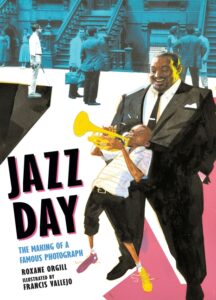 Jazz Day: The Making of a Famous Photograph
Jazz Day: The Making of a Famous Photograph
By Roxane Orgill
Illustrated by Francis Vallejo
Candlewick Press
$18.99
ISBN: 9780763669546
Ages 9-12
On shelves March 8th
Some books for kids have a hard road ahead of them. Here’s a secret. If you want a book to sell just oodles and oodles of copies to the general public, all you have to do is avoid writing in one of two specific genres: poetry and nonfiction. Even the best and brightest nonfiction books have a nasty tendency to fade from public memory too soon, and poetry only ever gets any notice during April a.k.a National Poetry Month. I say that, and yet there are some brave souls out there who will sometimes not just write poetry. Not just write nonfiction. They’ll write nonfiction-inspired poetry. It’s crazy! It’s like they care about the quality of the content more than make a bazillion dollars or something. The latest book to fall into this category is Jazz Day: The Making of a Famous Photograph by Roxane Orgill. Melding topics like jazz musicians and photography with history, poetry, and some truly keen art, this isn’t really like any other book on your shelves. I’m betting that that’s a good thing too.
It was sort of a crazy idea for a graphic designer / jazz buff to come up with. By 1958 jazz was a well-established, deeply American, musical genre. So why not try to get all the jazz greats, and maybe some up-and-comers, into a single photograph all together? The call went out but Art Kane (who really wasn’t a photographer himself) had no idea who would turn up. After all, they were going to take the picture at ten in the morning. That’s a time most jazz performers are fast asleep. Yet almost miraculously they came. Count Basie and Thelonious Monk. Maxine Sullivan and Dizzy Gillespie. Some of them were tired. Some were having a great time catching up with old friends. And after much cajoling on Kane’s part a photo was made. Fifty-seven musicians (fifty-eight if you count Willie “Lion” Smith just out of frame). Orgill tells the tale in poetry, with artist Francis Vallejo providing the art and life. Extensive backmatter consists of an Author’s Note, Biographies, a page on the photo and homages to it, Source Notes, and a Bibliography that includes Books, Articles, Audiovisual Material, and Websites.
Jazz is often compared to poetry. So giving this book too rigid a structure wouldn’t offer the right feel at all. I’m no poet. I wish I had a better appreciation for the art than I do. Yet even with my limited understanding of the style I found myself stopping when I read the poem “This Moment” written from the point of view of Eddie Locke, a drummer. It’s the kind of poem where it’s composed as a series of quatrains. The second and fourth lines of each stanza are repeated as the first and third lines of the next. It was fortunate for me that Orgill mentions in the back of the book that the poem is a pantoum. I’d never have come up with that term myself (I thought it was a sestina). Most of the poetry in the book isn’t really that formal. In fact, Orgill confesses that, “I write prose, not poetry. But this story demanded a sense of freedom, an intensity, and a conciseness that prose could not provide.” The result is that most of the poems are free verse, which I much preferred.
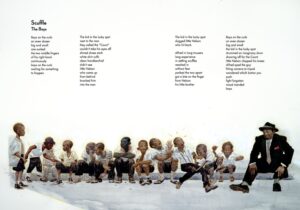 Did you know that when publishing a book for kids you’re not supposed to turn in your manuscript with an illustrator already attached? True fact. Editors like having the power to pair authors and artists together. To be honest, they have experience in this area and sometimes their intervention is sublime (sometimes it fails miserably too, but that’s a tale for another day). I’m afraid I don’t know what Candlewick editor saw Orgill’s manuscript and thought of Francis Vallejo as a potential illustrator. If I knew I’d kiss them. Detroit born Vallejo is making his debut with this book and you’d never know in a million years that he wasn’t a born and bred Harlemite. His style is perfect for this tale. As adept at comic style panels as he is acrylic and pastel jazz scenes, there’s life in this man’s art. It was born to accompany jazz. It’s also particularly interesting watching what he does with light. The very beginning of the book shows a sunrise coming up on a hot August day. As it rises, shadows make way. This play between light and shadow, between the heat of the photo shoot and the cool jazz clubs that occasionally make an appearance in the text, gives the book its heart. It’s playful and serious all at once so that when you lift the page that reveals the real photograph, that action produces a very real moment of awe.
Did you know that when publishing a book for kids you’re not supposed to turn in your manuscript with an illustrator already attached? True fact. Editors like having the power to pair authors and artists together. To be honest, they have experience in this area and sometimes their intervention is sublime (sometimes it fails miserably too, but that’s a tale for another day). I’m afraid I don’t know what Candlewick editor saw Orgill’s manuscript and thought of Francis Vallejo as a potential illustrator. If I knew I’d kiss them. Detroit born Vallejo is making his debut with this book and you’d never know in a million years that he wasn’t a born and bred Harlemite. His style is perfect for this tale. As adept at comic style panels as he is acrylic and pastel jazz scenes, there’s life in this man’s art. It was born to accompany jazz. It’s also particularly interesting watching what he does with light. The very beginning of the book shows a sunrise coming up on a hot August day. As it rises, shadows make way. This play between light and shadow, between the heat of the photo shoot and the cool jazz clubs that occasionally make an appearance in the text, gives the book its heart. It’s playful and serious all at once so that when you lift the page that reveals the real photograph, that action produces a very real moment of awe.
There’s been a lot of talk in the world of children’s literature lately about the research done on both works of fiction and nonfiction. Anytime you set your book in the past you have a responsibility to get the facts right. Part of what I love so much about Jazz Day is the extent of the research here. Orgill could easily have found a couple articles and books about the day of the photograph and stopped there. Instead, she writes that “Kane was by all accounts a wonderful storyteller, but one who did not always adhere to the facts. With the help of his son Jonathan Kane, I tried to set the story of the photograph straight.” Instructors who are teaching about primary sources in the schools could use this anecdote to show how reaching out to primary sources is something you need to do all the time. The rest of the backmatter (and it really is some of the most extensive I’ve ever seen) would be well worth showing to kids as well.
The question then becomes, whom is this book for? The complexity of the subject matter suggests that it’s meant for older kids. Those kids that might have a sense of some of the history (they might have heard what jazz is or who Duke Ellington was at some point in their travels). But would they read it for pleasure or as a kind of assigned reading? I don’t know. I certainly found it amusing enough, but I’m a 37-year-old woman. Not the target age range exactly. Yet I want to believe that there’s a fair amount of kid-friendly material here. Poems like “So Glad” and “quartet” may be about adults talking from an adult perspective, but Orgill cleverly livens the book up with the perspective of kids every step of the way. From the children sitting bored on the curb to a girl peering down from her window wishing the jazz men and photographer would just go away, kids get to give their two cents constantly. Read it more than once and you’ll begin to recognize some of them. Brothers Alfred and Nelson crop up more than a couple times too. Their mischief is just what the doctor ordered. With that in mind, it might be a good idea to have kids read different poems at different times. Save the more esoteric ones for later.
Jazz is hard to teach to kids. They know it’s important but it’s hard to make it human. There are always exceptions, though. For example, my 20-month-old is so obsessed with the book This Jazz Man by Karen Ehrhardt that he’ll have me read it to him a hundred times over. To my mind, that’s what this book is capable of, if at a much older level. It humanizes the players and can serve as a starting point for discussions, teaching units, you name it. These men and women are hot and tired and laughing and alive, if only at this moment in time. It’s a snapshot in both the literal and figurative sense. It’ll take some work to get it into the right hands, I suspect, but in the end it’s worth it. Jazz isn’t some weird otherworldly language. It’s people. These people. Now the kids in the book, and the kids reading this book, have a chance to get to know them.
On shelves March 8th.
Source: Galley sent from publisher for review.
Like This? Then Try:
Professional Reviews:


By:
Betsy Bird,
on 10/11/2014
Blog:
A Fuse #8 Production
(
Login to Add to MyJacketFlap)
JacketFlap tags:
Reviews,
Pat Mora,
Lee & Low Books,
Best Books,
Bilingual picture books,
Meilo So,
picture book poetry,
Best Books of 2014,
Reviews 2014,
2014 reviews,
2014 poetry,
Add a tag
 Water Rolls, Water Rises: El Agua Rueda, el Agua Sube
Water Rolls, Water Rises: El Agua Rueda, el Agua Sube
By Pat Mora
Illustrated by Meilo So
Children’s Book Press (an imprint of Lee & Low Books)
$17.95
ISBN: 978-0892393251
Ages 4-8
On shelves now.
Sometimes I wonder what effect the televised ephemera I took in as a child has had on my memories and references. For example, when I pick up a book like Pat Mora’s beautifully written and lushly illustrated Water Rolls, Water Rises: El Agua Rueda, el Agua Sube I immediately flash back to an old Sesame Street episode I enjoyed as a kid that showed a water sapped desert landscape made vibrant once more with the appearance of rain. Taken by itself, such a ran is an event that happens every day on Earth, and as such it’s the kind of thing tailor made to inspire a poet’s heart and mind. Poetry, sad to say, is not a form of literature that I excel in as a student. I can appreciate it, even quote it when called up to do so, but my heart belongs to prose first and foremost. If I have to read poetry, it helps to read the best of the best. Only really stellar poetry can crack my shell of indifference. And when you pair that really good verse alongside art that makes you want to stand up and cheer? That’s when you have a book that won’t just win over crusty old fogies like me, but also its intended audience: kids. Because if a book like Water Rolls, Water Rises can make me stop and think about the natural world, if only for a second, imagine what it could do for an actual child’s growing brain. Better things than old Sesame Street segments, that’s for sure.
We start slowly and watch the roll of the tides and the rise of the fog. The water is blown, then slithers and snakes, and in one particularly beautiful passage glides “up roots of tulips and corn.” After that, things pick up a bit. In swells the water sloshes, in woods it swirls, and it all culminates in storms and thunder and “lightning’s white flash.” Then, just as suddenly, all is calm again. Water rests in an oasis and slumbers in marshes. The book concludes with water joyfully “skidding and slipping”, “looping and leaping” until at last we pull back and view for ourselves our blue planet, “under gold sun, under white moon.” The bilingual text in both English and Spanish is complemented by illustrator Meilo So’s mixed media illustrations and contains both an Author’s Note and key for identifying the images in the book in the back.
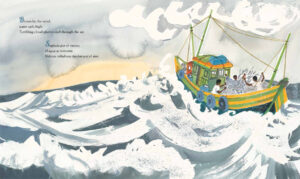 Now I’ll tell you right now that I don’t speak a lick of Spanish. I’ve the rudimentary single words and phrases culled from years of watching the aforementioned Sesame Street but there’s nothing substantial in my noggin. Therefore I cannot honestly tell you if the Spanish translation by Adriana Dominguez and Pat Mora matches the English text’s spare verse. Certainly I was impressed with the minimal wordplay Mora chose to use in this book. As someone prone to wordiness (I think the length of this review speaks for itself) I am always most impressed by those writers that can siphon a thought or a description down to its most essential elements. It’s hard to say what you’ll notice first when you read this book. Will it be the words or the art? Mora’s cadences (in English anyway) succeed magnificently in evoking the beauty and majesty of water in its myriad forms. Read the book enough times and you begin to get a real sense of the rise and fall of water’s actions. I also noted that Mora eschews going too deep into her subject matter. The primary concentration is on water as it relates to the landscape worldwide. She doesn’t dwell on something like water’s role in the human body or pepper the text with small sidebars pertaining to facts about water. This is poetry as it relates to liquid. Nothing more. Nothing less.
Now I’ll tell you right now that I don’t speak a lick of Spanish. I’ve the rudimentary single words and phrases culled from years of watching the aforementioned Sesame Street but there’s nothing substantial in my noggin. Therefore I cannot honestly tell you if the Spanish translation by Adriana Dominguez and Pat Mora matches the English text’s spare verse. Certainly I was impressed with the minimal wordplay Mora chose to use in this book. As someone prone to wordiness (I think the length of this review speaks for itself) I am always most impressed by those writers that can siphon a thought or a description down to its most essential elements. It’s hard to say what you’ll notice first when you read this book. Will it be the words or the art? Mora’s cadences (in English anyway) succeed magnificently in evoking the beauty and majesty of water in its myriad forms. Read the book enough times and you begin to get a real sense of the rise and fall of water’s actions. I also noted that Mora eschews going too deep into her subject matter. The primary concentration is on water as it relates to the landscape worldwide. She doesn’t dwell on something like water’s role in the human body or pepper the text with small sidebars pertaining to facts about water. This is poetry as it relates to liquid. Nothing more. Nothing less.
The bilingual picture book is fast becoming a necessity in the public library setting. Just the other day someone asked if we could have more Bengali/English picture books rather than just straight Bengali, because the parents liked reading both languages to their kids. Yet sadly in the past our bilingual literature has had a rough go of it. Well-intentioned efforts to give these books their own space in the children’s libraries have too often meant that they’re scuttled away in some long-forgotten corner. The patrons who need them most are often too intimidated to ask for them or don’t even know that they exist. So what’s the solution? Interfile them with the English books or all the other languages? Wouldn’t they be just as forgotten in one collection as another? There are no easy answers here and the thought that a book as a beautiful in word and image as Water Rolls could end up forgotten is painful to me.
Since this book travels around the world and touches on the lives of people in different lands and nations it is, by its very definition, multicultural. And to be honest, attaining the label of “multicultural” by simply highlighting different nations is easy work. What sets artist Meilo So’s art apart from other books of this sort is her fearless ability to upset expectations. I am thinking in particular of the image of the wild rice harvest in northern Minnesota. In this picture two children punt a boat through marshland. Their skin is brown, a fact that I am sure Ms. So did on purpose. Too often are white kids the “default” race when books that skate around the world make mention of the U.S. It’s as if the publishers forget that people of races aside from white live in America as well as the rest of the world. As such So elevates the standards for your average round-the-world book.
 Every book you pick up and read has to pass through your own personal filters and prejudices before it makes a home for itself in your brain. Let us then discuss what it means to be an English-only speaking American woman looking at this book for the first time. I pick up this book and I instantly assume that the cover is sporting an image of Niagara Falls. On the back of the jacket I come to a similar conclusion that we’re viewing Old Faithful. Thus does the American see the world only in terms of those natural wonders that happen to exist within her own nation’s borders. Turns out, that waterfall on the front is Victoria Falls, found between the countries of Zambia and Zimbabwe. And that geyser? Strokkur in Iceland. With this in mind you can understand why I was grateful for the little key in the back of the book that clearly identifies and labels (in both English and Spanish) where each location in the images can be found. It was interesting too to see each credit saying that the image was “inspired by” (“inspirada por”) its real world equivalent. I’ve been thinking a lot lately about accuracy in works of illustration in picture books. Mostly I’ve been thinking about historical accuracy, but contemporary landscapes raise their own very interesting questions. If Meilo So came up with the “inspired by” label then it may well be that it was thought up to protect her against critics who might look to her view of the Qutang Gorge, say, and declare her positioning of this or that mountain peak a gross flight of fancy. Since she is illustrating both distinct landmarks (the Grand Canyon, Venice’s Grand Canal, the coast of Cabo San Lucas, etc.) alongside places that typify their regions (a fishing boat at sea in Goa, India, a well in a rural village in Kenya, etc.) it is wise to simply give the “inspired by” designation to all images rather than a few here and there so as to avoid confusion.
Every book you pick up and read has to pass through your own personal filters and prejudices before it makes a home for itself in your brain. Let us then discuss what it means to be an English-only speaking American woman looking at this book for the first time. I pick up this book and I instantly assume that the cover is sporting an image of Niagara Falls. On the back of the jacket I come to a similar conclusion that we’re viewing Old Faithful. Thus does the American see the world only in terms of those natural wonders that happen to exist within her own nation’s borders. Turns out, that waterfall on the front is Victoria Falls, found between the countries of Zambia and Zimbabwe. And that geyser? Strokkur in Iceland. With this in mind you can understand why I was grateful for the little key in the back of the book that clearly identifies and labels (in both English and Spanish) where each location in the images can be found. It was interesting too to see each credit saying that the image was “inspired by” (“inspirada por”) its real world equivalent. I’ve been thinking a lot lately about accuracy in works of illustration in picture books. Mostly I’ve been thinking about historical accuracy, but contemporary landscapes raise their own very interesting questions. If Meilo So came up with the “inspired by” label then it may well be that it was thought up to protect her against critics who might look to her view of the Qutang Gorge, say, and declare her positioning of this or that mountain peak a gross flight of fancy. Since she is illustrating both distinct landmarks (the Grand Canyon, Venice’s Grand Canal, the coast of Cabo San Lucas, etc.) alongside places that typify their regions (a fishing boat at sea in Goa, India, a well in a rural village in Kenya, etc.) it is wise to simply give the “inspired by” designation to all images rather than a few here and there so as to avoid confusion.
After soaking in the art page by page I wondered then how much control Ms. Mora had over these images. Did she designate a country and location for each stanza of her poem? The book sports an Author’s Note (but no Artist’s Note, alas) that mentions the places Ms. Mora has traveled too. Look at the list of locations and they do, indeed, appear in the book (China, Holland, Peru, Finland, etc.). So I make the assumption that she told Ms. So what country to draw, though I don’t know for sure.
As a mother of two small children, both under the age of 4, my interest in early brain development has been piqued. And like any mother I berate myself soundly when I feel like my own personal prejudices are being inflicted on my kids. I don’t go gaga for poetry but that doesn’t mean I shouldn’t read it to the kiddos as much as possible. Fortunately, books like Water Rolls, Water Rises make the job easy. Easy on the eyes and the ears, this is one clever little book that can slip onto any home library shelf without a second thought. Sublime.
On shelves now.
Source: F&G sent from publisher for review.
Like This? Then Try:
- Water Can Be… by Laura Purdie Salas, illustrated by Violeta Dabija

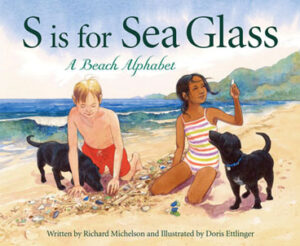 S is for Sea Glass
S is for Sea Glass
By Richard Michelson
Illustrated by Doris Ettlinger
Sleeping Bear Press
ISBN: 978-1585368624
$15.95
Ages 3-8
On shelves now
Every small publisher needs a staple. Something to keep them going through hard times. Years ago Sleeping Bear Press hit on the notion of writing books with the [letter] is for [word] format and they’ve kept up this abecedarian staple ever since. These are books that are fairly easy to dismiss, sight unseen. You assume you know what to expect. Never mind that they’ve a range of different subjects, authors, and illustrators. For the picture book snob, one glance at the title and you’re immediately dismissive. You think you know what to expect. And of course by “you” I really mean “me”. It was the fact that S is for Sea Glass was written by Richard Michelson that gave me pause. No fly-by-night poet he, I sat down with the book and was happy to find that my expectations weren’t just met but greatly exceeded. Chalk that up to my own personal prejudices then. In this book Michelson and artist Doris Ettlinger gracefully sit back and present to us a most thoughtful, meditative picture book on summer and sea and the relationship between the two. Absolutely lovely and original, this is a summer book of poetry worth remembering and revisiting year after year after year.
“A is for Angel” begins the book. Open it and here you’ll see a girl on her back in the sand. She swings her arms and legs up and down “Like I’m opening and closing a fairy-tale gate” creating sand angels behind her. Welcome to summer. To beaches and tides and those elements of the season a kid can’t wait to experience. Through poetry, Richard Michelson brings to life the little details that make a summer come alive. From doomed sand castles to morally superior seagulls to the child that dreams of someday living in a lighthouse so they’d never have to leave, Michelson places a good, firm finger on the pulse of the warmer months. Artist Doris Ettlinger accompanies him and brings to life not just the obvious moments of summertime but some of the softer more esoteric feelings conjured up by Michelson’s words. The result is a book that will almost smell to you of brine and surf, even in the coldest, frozen depths of the winter.
 What is the moment when a book flips that switch in your brain from “like” to “love”? It’s different for everyone. For some it might be a word or a phrase. For others a haunting image or illustration that conjures up a personal memory. In the case of S is for Sea Glass it was the poem “H is for Horizon”. It’s not out-and-out saying you need to contemplate the nature of infinity but it might well be suggesting it. After all, is there any point on the beach so wrought with possibility and promise? As Michelson writes, “If I travel the world or stay here on this beach, / The horizon will always be just beyond reach. / But it’s real as my dreams and it’s always nearby – / That magical line where the sea meets the sky.” Inculcating a kid in poetry that’s fun because the language is fun is as easy as the next Shel Silverstein poem. Inculcating a kid in poetry that’s fun because it expands your horizons (pun intended) and lets your mind wander free is much harder. Michelson manages it here.
What is the moment when a book flips that switch in your brain from “like” to “love”? It’s different for everyone. For some it might be a word or a phrase. For others a haunting image or illustration that conjures up a personal memory. In the case of S is for Sea Glass it was the poem “H is for Horizon”. It’s not out-and-out saying you need to contemplate the nature of infinity but it might well be suggesting it. After all, is there any point on the beach so wrought with possibility and promise? As Michelson writes, “If I travel the world or stay here on this beach, / The horizon will always be just beyond reach. / But it’s real as my dreams and it’s always nearby – / That magical line where the sea meets the sky.” Inculcating a kid in poetry that’s fun because the language is fun is as easy as the next Shel Silverstein poem. Inculcating a kid in poetry that’s fun because it expands your horizons (pun intended) and lets your mind wander free is much harder. Michelson manages it here.
The nice thing about the poems is that they aren’t the usual beach fare. Sure you’ll find the standard “O is for Ocean” or “W is for Wave” but Michelson has an impish quality to his selections. “E is for Empty Shells” isn’t just about the shells you find on the beach but also the fact that their innards have been consumed by YOU much of the time. “I is for Ice” isn’t about the cubes in a glass on a hot day but rather the strange and startling beauty of a beach in the blustery depths of winter. Some of the poems will take some practice to read aloud, so parents be ready. “B is for Boardwalk” for example eschews the regular ABAB rhyme scheme for something a little more visually exciting. “D is for Dog” in contrast contains both hard and soft rhymes. There are poems with AABB rhymes and even haikus like the one in “P is for Pail”. Michelson doesn’t distinguish or label the different types of poetry found here, so in terms of curricular ties that feels like a lost opportunity.
It’s always interesting to watch what a kid latches onto in a book like this. My 3-year-old has recently been on a beach books kick. We’d already exhausted Splash, Anna Hibiscus, Ladybug Girl at the Beach, Scaredy Squirrel at the Beach and many others when we came across S is for Sea Glass. My daughter enjoyed the poems, treating each one with equal interest, but the poem she kept going back to and appeared to be haunted by was “Q is for Quiet”. I suspect this may have a lot to do with the image in that book which also appears on the back cover. In it, a girl sleeps, half her hair dark, the other silver white in the moonlight. As she dreams a shoal of fish swim about her across the star strewn sky. Many’s the time we’ve read the book and just come to a dead stop at Q. No need to go further. She gets everything she needs out of this poem alone.
 Credit where credit is due to artist Doris Ettlinger then. I was aware of Ms. Ettlinger’s work thanks to books like The Orange Shoes (it tends to come up when patrons want picture books on class distinctions) and other books in the Sleeping Bear Press series. The sea appears to be particularly inspirational to Ms. Ettlinger, though. A strictly representational illustrator most of the time, here her watercolors find much to enjoy in the roaring pounding surf, the ice choked chill of a wintertime beach jaunt, the infinity of the deepest ocean, and that gray/brown gloomy beauty of a rained out beach. The “R is for Rain” sequence in particular is one of her loveliest. Credit too to “Y is for Year-Rounders” where seaside locals celebrate a town empty of tourists in the fall. In her version, Ettlinger conjures up a small town beach resort street at the end of the day, four family members and their dog just tiny black silhouettes against the blazing yellow of a setting sun.
Credit where credit is due to artist Doris Ettlinger then. I was aware of Ms. Ettlinger’s work thanks to books like The Orange Shoes (it tends to come up when patrons want picture books on class distinctions) and other books in the Sleeping Bear Press series. The sea appears to be particularly inspirational to Ms. Ettlinger, though. A strictly representational illustrator most of the time, here her watercolors find much to enjoy in the roaring pounding surf, the ice choked chill of a wintertime beach jaunt, the infinity of the deepest ocean, and that gray/brown gloomy beauty of a rained out beach. The “R is for Rain” sequence in particular is one of her loveliest. Credit too to “Y is for Year-Rounders” where seaside locals celebrate a town empty of tourists in the fall. In her version, Ettlinger conjures up a small town beach resort street at the end of the day, four family members and their dog just tiny black silhouettes against the blazing yellow of a setting sun.
When the weather warms and the leaves reappear on the trees, then it will be the time for families to pluck S is for Sea Glass from the topmost shelves of their bookcases for multiple reads by the seashore. We all do that, right? Keep our seasonal books apart from one another so that when the right time of year appears we’ve books ah-plenty to refer to? Well, if you haven’t before I recommend you start now with this one. Parents buy summery beach titles for their kids regardless of the quality. All the more reason the care and attention paid to “S is for Sea Glass” impresses. There are books a parent does not wish to read 100 times over to their offspring and there are books they wish they could read even more. This book falls into the latter category. A treat for eye and ear alike.
On shelves now.
Source: Final copy given by author for review.
Like This? Then Try:
Other Blog Reviews:
Misc: A discussion with Michelson about the book on MassLive.
Videos: A peek inside.


By:
Betsy Bird,
on 5/22/2014
Blog:
A Fuse #8 Production
(
Login to Add to MyJacketFlap)
JacketFlap tags:
poetry,
Eerdmans Books for Young Readers,
picture book poetry,
Reviews 2014,
2014 reviews,
2014 poetry,
David Colmer,
Sieb Posthuma,
Annie M.G. Schmidt,
Reviews,
Add a tag
 A Pond Full of Ink
A Pond Full of Ink
By Annie M.G. Schmidt
Illustrated by Sieb Posthuma
Translated by David Colmer
Eerdmans Books for Young Readers
$16.00
ISBN: 978-0-8028-5433-9
Ages 7 and up
On shelves now
International children’s authors are great. They’re just not particularly well known in America. There are various reasons for this. Some of it has to do with the dearth of international children’s book importing. Bringing a book over sometimes requires translation, and there’s often little hope of the writer or illustrator touring if English isn’t a second language. Then add to this the fact that all the major children’s book awards in the U.S. have to go to American residents. Once in a while there’s an exception to these rules, of course. You’ll get a Shaun Tan or a Mem Fox (both Aussies, but you know what I mean). Generally, however, we dwell in ignorance and have to make an effort to know who else is out there in the world. Consider then the case of Annie M.G. Schmidt. If international children’s book authors are rarities on our fair shores, what are we to make of international children’s poets? Finding poetry for children here in the U.S. is a tricky enough proposition as it is. Add in the international element and it’s little surprise that Schmidt’s name rings few bells. Fortunately, our ignorance is our children’s gain. A Pond Full of Ink proves a charming collection of Schmidt’s work, translated expertly, original to its core.
“A fairy tale author I know / starts work every day when the roosters crow.” So begins the first poem in this collection of children’s poet Annie M.G. Schmidt. Twelve poems, judiciously edited, perfectly selected, are paired with the ribald art of illustrator Sieb Posthuma. Readers who flip through the pages will encounter everything from thieves that covet the moon to a teakettle with musical aspirations. The end result is a collection that is silly, subversive, and sly by turns.
 So what do we know about Annie M.G. Schmidt? Well, I looked about and heard at least one person refer to her as, “something like the Dutch Astrid Lindgren, [who] never broke through in the English-speaking world.” That would be translator David Colmer’s description. Looking her up I found various sites praising her, saying things like “almost everyone in the Netherlands is able to recite at least a line or two from one of her songs or poems. Her children’s books have become a national institution.” We might call her the Dutch Dr. Seuss then. As this is pretty much the only book of Ms. Schmidt’s that we have here in the U.S., A Pond Full of Ink has a lot of promise to fulfill. Fortunately, and as it just so happens, the book is charming. Akin to something along the lines of Shel Silverstein in terms of the unconnected ridiculous, Schmidt dwells on the silly and the thoughtful alike. Every person I know who has read this book has his or her own individual favorites. For my part, I was quite partial to “The Furniture”. Kids will pick their preferences. In fact, the book would actually be ideal for children’s book groups since each child would have their own personal faves.
So what do we know about Annie M.G. Schmidt? Well, I looked about and heard at least one person refer to her as, “something like the Dutch Astrid Lindgren, [who] never broke through in the English-speaking world.” That would be translator David Colmer’s description. Looking her up I found various sites praising her, saying things like “almost everyone in the Netherlands is able to recite at least a line or two from one of her songs or poems. Her children’s books have become a national institution.” We might call her the Dutch Dr. Seuss then. As this is pretty much the only book of Ms. Schmidt’s that we have here in the U.S., A Pond Full of Ink has a lot of promise to fulfill. Fortunately, and as it just so happens, the book is charming. Akin to something along the lines of Shel Silverstein in terms of the unconnected ridiculous, Schmidt dwells on the silly and the thoughtful alike. Every person I know who has read this book has his or her own individual favorites. For my part, I was quite partial to “The Furniture”. Kids will pick their preferences. In fact, the book would actually be ideal for children’s book groups since each child would have their own personal faves.
Just as I was unaware of the existence of Ms. Schmidt, so too was I unfamiliar with the art of Sieb Posthuma. Dutch too, Mr. Posthuma gives this book a distinct flavor entirely of his own. In fact, a little digging found that for this book Mr. Posthuma actually won the 2012 Gouden Penseel or Golden Paintbrush, the top prize for children’s books originally published in The Netherlands. One sees why. There’s a sly, clever quality to Posthuma’s art here. From the vampire fanged little girl of “Nice and Naughty” to bespectacled deer of “Aunty Jo” you can’t help but like these characters. Best of all, the book isn’t afraid to take a moment to just enjoy the art. There are several wordless two-page spreads that offer a quiet accompaniment to their preceding poems. Like the lush greenery of “Aunt Sue and Uncle Steve” or the blue and red vision of sea and land after “Three Elderly Otters”, Posthuma has been given the chance to muse.
 It’s not that I haven’t heard objections to the book. Some folks I’ve shown this too have questioned the translation, saying that only some poems really spoke to them. For my part, I think the translation keen. For one thing, David Colmer, the translator, had to translate rhyme. I just can’t even begin to imagine how hard that must be. Not only must the poems scan but rhyme as well? It’s at this point that one begins to wonder how the invisible hand of the translator plays into the text. With some digging I discovered that David Colmer is an Australian translator of Dutch literature based in Amsterdam. He seems to do particularly well when it comes to translating poetry and works for children. As a four-time winner of the David Reid Poetry Translation Prize, the man also appears to know what he is doing. I cannot even begin to fathom how one aligns scansion and rhyme in translation. All I can do is trust that Colmer does it well.
It’s not that I haven’t heard objections to the book. Some folks I’ve shown this too have questioned the translation, saying that only some poems really spoke to them. For my part, I think the translation keen. For one thing, David Colmer, the translator, had to translate rhyme. I just can’t even begin to imagine how hard that must be. Not only must the poems scan but rhyme as well? It’s at this point that one begins to wonder how the invisible hand of the translator plays into the text. With some digging I discovered that David Colmer is an Australian translator of Dutch literature based in Amsterdam. He seems to do particularly well when it comes to translating poetry and works for children. As a four-time winner of the David Reid Poetry Translation Prize, the man also appears to know what he is doing. I cannot even begin to fathom how one aligns scansion and rhyme in translation. All I can do is trust that Colmer does it well.
For my part, the only real objection I had to the book was the design. The poems are written in a typewriter-like font. No problems there. But occasionally the poems appear in large, unwieldy clumps. When integrated with the text, as they are with the poems “Three Elderly Otters” or “The Man Who Writes Fairy Tales” they can be lovely. But in cases like “Belinda Hated Getting Clean . . .” even adult readers will feel daunted when faced with a full page of tiny poetic type without so much as a break or an indentation to be seen. I don’t suppose there was much that could have been done about this when the book was translated for America, but it’s a pity just the same.
It is encouraging to think that though Ms. Schmidt was never brought to America in her lifetime, posthumously her words can fulfill their destiny decades after her death. A Pond Full of Ink does not attempt to be anything other than what it is. A short, smart selection of fun poems for kids of every age. A small clever treat, consider its loaded silliness for your own personal collection.
On shelves now.
Source: Advanced reading copy sent from publisher for review.
Like This? Then Try:
Other Blog Reviews: Children’s Illustration,
Professional Reviews:
Misc:
- So how did translator David Colmer tackle this book? Get the inside scoop here.
Videos:
A book trailer! Who would have thunk it?


By:
Betsy Bird,
on 1/31/2013
Blog:
A Fuse #8 Production
(
Login to Add to MyJacketFlap)
JacketFlap tags:
Reviews,
poetry,
Jack Prelutsky,
Harper Collins,
Best Books,
Greenwillow,
Carin Berger,
funny picture books,
funny poetry,
picture book poetry,
Best Books of 2013,
Reviews 2013,
2014 Caldecott Contender,
2013 funny books,
2013 poetry,
Add a tag
 Stardines Swim High Across the Sky and Other Poems
Stardines Swim High Across the Sky and Other Poems
By Jack Prelutsky
Illustrated by Carin Berger
Greenwillow Books (an imprint of Harper Collins)
$16.99
ISBN: 978-0-06-201464-1
Ages 4-8
On shelves February 26th.
To non-children’s librarians the statistics are baffling. Your average poetry book isn’t exactly a circ buster. It sits on the shelf for months at a time, gathering dust, biding its time. When kids come to the reference desk to ask for titles, they don’t tend to ask for poetry unless they’ve some sort of assignment they need to fulfill. Yet for all that poetry books for kids are shelf sitters, it’s hard to find a single one that hasn’t gone out in the last two or three months. How to account for it? Well, there’s Poetry Month (April) to begin with. That always leads to a run on the 811 portion of the library shelves. But beyond that kids read poetry in dribs and drabs over the course of the year. Maybe as Summer Reading books. Maybe as class assignments. Whatever the reason, poetry has a longevity, if not a popularity, that’s enviable. Now Jack Prelutsky, our first Children’s Poet Laureate and creator of Behold the Bold Umbrellaphant is following up his work with yet another delve into (in the words of Kirkus) “iambic ‘pun’tameter”. And while Prelutsky gives us a second round, illustrator Carin Berger steps up her game to give these hybrid birds and beasts a kick in the old artistic derriere.
 Forget everything you ever knew about animals. Not since On Beyond Zebra has the world seen a menagerie quite as wild as the one on display here. Step right up, folks, and take a gander at the rare and remarkable Fountain Lion. “The only lions no one dreads, / They all have fountains on their heads.” Delicious crustaceans more your speed? Then come and observe the rare Slobsters. “Their sense of decorum / Is woefully small. / Slobsters don’t have / Many manners at all.” Or for the kiddies, how about an adorable Planda? “They plan to learn to roller-skate, / To juggle, and to fence. / They plan to go to clown school / And cavort in circus tents.” With his customary clever verse, Jack Prelutsky invents sixteen imaginary animals of varying degrees of odd. Accompanying his rhymes is his old partner-in-crime Carin Berger, who has moved beyond mere collage and has gone so far to construct elaborate shadow boxes of each and every poem. The end result is impressive, hilarious, and one of the most original little poetry collections you’ll see in many a year.
Forget everything you ever knew about animals. Not since On Beyond Zebra has the world seen a menagerie quite as wild as the one on display here. Step right up, folks, and take a gander at the rare and remarkable Fountain Lion. “The only lions no one dreads, / They all have fountains on their heads.” Delicious crustaceans more your speed? Then come and observe the rare Slobsters. “Their sense of decorum / Is woefully small. / Slobsters don’t have / Many manners at all.” Or for the kiddies, how about an adorable Planda? “They plan to learn to roller-skate, / To juggle, and to fence. / They plan to go to clown school / And cavort in circus tents.” With his customary clever verse, Jack Prelutsky invents sixteen imaginary animals of varying degrees of odd. Accompanying his rhymes is his old partner-in-crime Carin Berger, who has moved beyond mere collage and has gone so far to construct elaborate shadow boxes of each and every poem. The end result is impressive, hilarious, and one of the most original little poetry collections you’ll see in many a year.
The shadow box, that staple of undergraduate art projects everywhere, is a relative newcomer to the world of children’s literature. A shadow box, once you’ve designed it and filled it with cool images, needs to be photographed perfectly if it’s going to work on a flat page. That means you need an illustrator confident in their abilities to produce art that will look as good in two dimensions as three. Berger is clearly up to the challenge. A master of collage, in this book she bends over backwards to make her images the best they can be. She’s very good at conveying distance. She also conveys perspective quite well. A cut image of a bicycle makes it appear to be three-dimensional because it is photographed from above. I know the image itself is just a flat piece of paper, but the illusion is complete. Everything, in fact, appears to have been planned with a meticulous eye.
Even within the boxes themselves Berger’s job is not easy. Consider an early poem called “Bluffaloes” which combines the word “Buffaloes” with the word “Bluff”. It’s about buffalo types who are scaredy cats should you call their bluff. Fair enough. Now how the heck do you illustrate that? In Berger’s case it looks like she may have considered an alternative definition of the word “bluff” as in “a cliff, headland, or hill with a broad, steep face” since her bluffaloes look like nothing so much as little pieces of a cliff running hither and thither on newly sprouted legs. Artistic creativity is much called for when wordplay is open ended.
 Of course, as an adult I’m going to be naturally inclined towards artsy fartsy styles. But this all begs the obvious question: Will kids dig it? Well, let’s stop and consider for a moment. What precisely has Berger done? She has made little boxes and put action-packed scenes within them. Who else does that kind of thing? If you said, “Kids who make dioramas for school” you have earned yourself a cookie. Yes, it appears to me that Berger has taken one of the oldest homework assignments of our age and has turned it into a book. An enterprising teacher would find a goldmine of assignment material here. What if they had their kids write their own poems in Prelutsky’s style? What if they made pairs of kids come up with the idea for the poem and then one kid could write it while the other made a diorama to go with it? Can you now say, “instantaneous original poetry project for Poetry Month”? I knew you could.
Of course, as an adult I’m going to be naturally inclined towards artsy fartsy styles. But this all begs the obvious question: Will kids dig it? Well, let’s stop and consider for a moment. What precisely has Berger done? She has made little boxes and put action-packed scenes within them. Who else does that kind of thing? If you said, “Kids who make dioramas for school” you have earned yourself a cookie. Yes, it appears to me that Berger has taken one of the oldest homework assignments of our age and has turned it into a book. An enterprising teacher would find a goldmine of assignment material here. What if they had their kids write their own poems in Prelutsky’s style? What if they made pairs of kids come up with the idea for the poem and then one kid could write it while the other made a diorama to go with it? Can you now say, “instantaneous original poetry project for Poetry Month”? I knew you could.
Then there’s Prelutsky. He always scans. He always rhymes. And he throws in big words that will give some children a good dictionary workout. For example, in the Sobcat poem he writes, “The SOBCAT is sad / As a feline can be / And spends its time crying / Continuously. / It has no real reason / To be so morose. / It’s simply its nature / To act lachrymose.” Nice. Of course the unspoken secret to many of these poems isn’t that they simply make clever pairings of words and phrases with animals but that they say something about certain types of people. The Planda makes eternal plans and never carries them out. The Sobcat “delights / In its own misery”. You can find many a friend and a relation found in the animals of these pages.
The pairings of the poems is sometimes key. It works particularly well when you place the “Jollyfish” poem next to the “Sobcat”, for example. There are other moments when you suspect that the layout and order of the poems was a carefully thought out process. The book begins, for example, with the titular poem “Stardines” which comments that “In silence, these nocturnal fish / Are set to grant the slightest wish.” That’s a good note to begin on. The book then alternates between animals with physical attributes that are their primary lure and animals with one-of-a-kind personality quirks. It’s interesting to see how all this ends with, of all the animals, the Bardvark. “BARDVARKS think they’re poets / And persist in writing rhyme. / Their words are uninspired / And a total waste of time.” So it is that book of poetry for kids ends by highlighting an animal that’s an atrocious poet. The final lines, “Undeterred, they keep on writing / And reciting every day. / That’s why BARDVARKS are a problem – / You can’t make them go away.” One can’t help but think Prelutsky is taking a little jab at himself here. Not a significant jab, but small enough to allow him to laugh at himself a little. Not a bad way to finish, really.
 Perhaps a key at the back of the book explaining which animals and concepts were combined would not have been out of place. I found myself baffled by the “swapitis” (pronounced swap-uh-teez) and found myself wishing I knew what animal it hailed from. It looks somewhat deer-like. After a bit of internet searching I discovered an animal called a wapitis, which is a kind of North American deer. Good to know, though I suspect it won’t immediately pop to many folks’ minds unless prompted and prodded a bit. Of course having kids find the animals referenced could be a fun homework assignment in and of itself. There are possibilities there. Just no answers.
Perhaps a key at the back of the book explaining which animals and concepts were combined would not have been out of place. I found myself baffled by the “swapitis” (pronounced swap-uh-teez) and found myself wishing I knew what animal it hailed from. It looks somewhat deer-like. After a bit of internet searching I discovered an animal called a wapitis, which is a kind of North American deer. Good to know, though I suspect it won’t immediately pop to many folks’ minds unless prompted and prodded a bit. Of course having kids find the animals referenced could be a fun homework assignment in and of itself. There are possibilities there. Just no answers.
Jack Prelutsky is a staple. Folks my age still associate him with The New Kid On the Block. Kids these days have a lot more Prelutskyian choices to pick from. Berger, in contrast, is new and fresh and bright and shiny. Combine the old school rhymes and chimes of a Prelutsky with the crackling energy and visual wit of Berger and you’ve got yourself a heckuva team. Stardines may tread familiar ground once trod before, but its method of presentation is anything but overdone. Hand this one to the kid who moans to you that they “have” to read a book of poetry for school. Who knows? It may hook ‘em before they realize what’s what. One of a kind.
On shelves February 26th.
Source: Galley sent from publisher for review.
Like This? Then Try:
- Wabi Sabi by Mark Reibstein, illustrated by Ed Young
Other Blog Reviews: Book Aunt
Professional Reviews:
Misc:
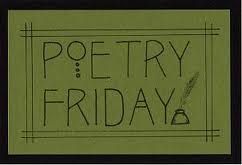 Read this great little short interview with Ms. Berger at Seven Impossible Things Before Breakfast as she discusses how, “This seemed a perfect opportunity to reference my passion for wunderkammers and early science — and crusty old museums.”
Read this great little short interview with Ms. Berger at Seven Impossible Things Before Breakfast as she discusses how, “This seemed a perfect opportunity to reference my passion for wunderkammers and early science — and crusty old museums.”
- It’s Poetry Friday! Head on over to Teaching Authors to see the round-up of other great poetry books of the day!
Video:
Take a studio tour into the world of Carin Berger to see some of the fantastic art from this book.







By:
Betsy Bird,
on 8/10/2012
Blog:
A Fuse #8 Production
(
Login to Add to MyJacketFlap)
JacketFlap tags:
Uncategorized,
poetry,
picture books,
photography,
Candlewick,
Helen Frost,
picture book poetry,
2012 picture books,
2012 reviews,
2012 poetry,
Best Books of 2012,
Rick Lieder,
picture book photography,
Add a tag
 Step Gently Out
Step Gently Out
By Helen Frost
Photographs by Rick Lieder
Candlewick Press
$15.99
ISBN: 978-0-7636-5601-0
Ages 3-8
On shelves now
I have lots of little soapboxes scattered around my home that I like to pounce on in idle moments. Big soapboxes. Little soapboxes. Anyone who knows me is forced to hear me expound from one of them at least once daily. It’s rare that I get to shove two of them together, though. Usually they represent separate entities that don’t overlap. Picking up the remarkably gorgeous work that is Helen Frost and Rick Lieder’s Step Gently Out, however, allows me to stack one soapbox on top of another. That may make them a little more difficult to balance on, but with practice I’ll have it down pat. From that perch I can then cry to the heavens above, “Why is there no poetry award for children’s books given out by the American Library Association?” while also bemoaning, “Why has a work of photography never won a Caldecott Award?” Yes, Step Gently Out appears to be a double threat. Poetry meets photography in a single undulating poem. And if my soapbox seems strange, it will make all the more sense when you learn that the pair behind the book includes the remarkable poet Helen Frost and photographer extraordinaire Rick Lieder. Put them both together and you’d be a fool to overlook this book for any reason whatsoever.
“Step gently out,” the book urges us. “… be still, and watch a single blade of grade.” As we follow the words and instructions we are brought in close to a wide array of common backyard insects. An ant lifts its head from the center of a yellow flower and is “bathed in golden light.” A spider weaves webs soaked in droplets and we hear that “they’re splashed with morning dew”. By the end we begin to understand them better and the text closes with “In song and dance and stillness, they share the world with you.” A final two-page spread at the end identifies all the insects shown in the book and gives some facts about their lives.
 Reading through the book a couple times I couldn’t help but wonder if the photos came first or the poem. Did Ms. Frost see Lieder’s work and construct just the right poem to accompany the images? After all, there are specific mentions of many of the bugs you’ll find in the photographs. Or did Mr. Lieder read Ms. Frost’s poem and then set out to find the right insects required to carry her vision? Or (a third idea just came to me) was this a case of an already existing poem and already existing photographs coming together by a clever editor, seeming to fit from the start? I simply do not know.
Reading through the book a couple times I couldn’t help but wonder if the photos came first or the poem. Did Ms. Frost see Lieder’s work and construct just the right poem to accompany the images? After all, there are specific mentions of many of the bugs you’ll find in the photographs. Or did Mr. Lieder read Ms. Frost’s poem and then set out to find the right insects required to carry her vision? Or (a third idea just came to me) was this a case of an already existing poem and already existing photographs coming together by a clever editor, seeming to fit from the start? I simply do not know.
For parents wishing to instill in their children a sense of Zen, often they’ll turn to something like Jon J. Muth’s Zen Shorts and the like. A worthy choice, but if what you are trying to do is to give your kids a sense of communion with nature on its most basic and essential level, Step Gently Out is the bett

By:
Betsy Bird,
on 9/11/2011
Blog:
A Fuse #8 Production
(
Login to Add to MyJacketFlap)
JacketFlap tags:
Uncategorized,
poetry,
peace,
Anna Grossnickle Hines,
Henry Holt and Company,
macmillan,
picture book poetry,
2011 reviews,
2011 poetry,
quilt illustration,
Add a tag
 Peaceful Pieces: Poems and Quilts About Peace
Peaceful Pieces: Poems and Quilts About Peace
By Anna Grossnickle Hines
Henry Holt (Macmillan)
$16.99
ISBN: 978-0-8050-899607
Ages 4-8
On shelves now.
Folks will ask for it. Sure they will. You sit at a children’s reference desk in a library long enough and eventually somebody is going to ask you for a book on the topic of “peace”. As a librarian, you’re in a pickle. See, you want to give them what they want, and certainly there is no lack of peace-related books for children out there. But since you’re a librarian you want to get your patrons to best of the best. And to be perfectly frank, I’d say that the bulk of peace books for kids out there are dreck. Goopy, icky, sentimental crud. There are exceptions, of course. Books like The Big Book for Peace for example are pretty good without dipping a toe too often in the tempting waters of didacticism. Poetry exists too but as with most things it’s hard to separate the good from the bad. You get a leg up if the art’s extraordinary, though. Now Anna Grossnickle Hines probably ranks as one of the top (maybe THE top) quilt-based illustrators of children’s books on the North American continent. I regularly use her 1, 2 Buckle My Shoe in my Toddler Storytimes. Her art is delightful but I admit to suppressing a small sigh when I saw that she’d created a book of peace poems. Fortunately I was pleased to discover that quite a few of these are pretty good. The poems are far more touch and go than the art, but all in all the collection is strong. And pretty. Did I mention pretty? Pretty.
“O peace, / why are you such / an infrequent guest?” In twenty-eight poems Anna Grossnickle Hines seeks to answer that very question and to come up with solutions to some close-to-home problems that kids face all the time. Set against a backdrop of handmade quilts of her own making, Hines tackles both the big questions and the small. A boy considers what would happen if he frightened away a deer, while another stands nose to nose with his sister until their anger is forgotten and somebody laughs. One poem shows that if you say “peace” over and over again the word turns your lips into a smile. They discuss the domino effect and the role of fear as it relates to violence. Through it all, the quilts capture these poems and reflect them like cloth prisms. Notes at the end of the book list some Peacemakers of the world (everyone from Jimmy Carter to Dorothy Day, and even a couple kids as well) and a section called “Peaceful Connections” discusses the creator’s quilting process.
 Most collections of poetry for kids contain some poems that are top notch and others that are so-so. This is just as true for books of different poets as it is for a single poet writing a bunch of poems. Hines is a good poet, but the collection starts off slowly. The poems “Making an Entrance”, “An Invitation” and “Wher
Most collections of poetry for kids contain some poems that are top notch and others that are so-so. This is just as true for books of different poets as it is for a single poet writing a bunch of poems. Hines is a good poet, but the collection starts off slowly. The poems “Making an Entrance”, “An Invitation” and “Wher

By:
Betsy Bird,
on 8/11/2011
Blog:
A Fuse #8 Production
(
Login to Add to MyJacketFlap)
JacketFlap tags:
Uncategorized,
poetry,
Kevin Hawkes,
Candlewick,
Marilyn Nelson,
picture book poetry,
Pamela Paul,
2011 reviews,
2011 poetry,
Danish children's literature,
Halfdan Rasmussen,
Add a tag
 A Little Bitty Man and Other Poems for the Very Young
A Little Bitty Man and Other Poems for the Very Young
By Halfdan Rasmussen
Translated by Marilyn Nelson and Pamela Espeland
Illustrated by Kevin Hawkes
Candlewick Press
$15.99
ISBN: 978-0763623791
Ages 3-8
On shelves now.
Denmark! Mention the country and children’s literature in one breath and what would most Americans think of? Well, if they were well-versed in the form they might think of Hans Christian Andersen. Our national interest in children’s authors from other countries is sparse, but once in a while someone pierces the collective unconscious. Unfortunately for us, Danish children’s literature begins and ends with the esteemed Andersen. For all we know, that country’s interest in kids’ fare began and ended with his reign. So it was with great interest that I became acquainted with one Halfdan Rasmussen. Former resistance fighter against the German occupation, human rights advocate, and children’s poet, the man wore many a hat in his day. Having already been introduced to U.S. kids in the previous publication The Ladder, Rasmussen returns to our public eye with a collection of younger fare. Sweet and jaunty by turns, A Little Bitty Man exhibits all the best aspects of classic children’s poetry. You may have never known this Rasmussen fellow before but after reading this you’ll be happy to make his acquaintance.
Thirteen poems of relative brevity are collected together. Ranging from the realistic to the fantastical, Rasmussen dares to spark young imaginations with this collection. In it you’ll encounter an elf with a singular method of retaining warmth in a chilly proboscis, a dolly with latrophobia, incontinent rainclouds, clever goats, literary fowl, and many more. Accompanied by the delicate, charming illustrations of Kevin Hawkes, this is one poetic introduction you’ll be happy to have made.
 I can’t think of the last time a funny poem for kids made me laugh out loud. So imagine my surprise when I found myself reading the poem “You Can Pat My Pet” and ran across these two stanzas: “You can pat my dog for a dime / and my horse for an egg and a half. / You can pat my favorite aunt / if you give me your granddad’s moustache.” It proceeds to get sillier after that but I just love the exchange of aunt patting for facial hair. Rasmussen does not choose to be a funny poet for kids or a meaningful one. He’s both at once. For the most part, when Rasmussen is trying to be insightful, he succeeds. “What Comes Next” is lovely. “What Things Are For” feels like a natural companion to the picture book A Hole Is to Dig by Ruth Krauss. The sole fly in the ointment is “Those Fierce Grown-Up Soldiers” which is the kind of poem we’ve seen done a hundred times before, and never particula
I can’t think of the last time a funny poem for kids made me laugh out loud. So imagine my surprise when I found myself reading the poem “You Can Pat My Pet” and ran across these two stanzas: “You can pat my dog for a dime / and my horse for an egg and a half. / You can pat my favorite aunt / if you give me your granddad’s moustache.” It proceeds to get sillier after that but I just love the exchange of aunt patting for facial hair. Rasmussen does not choose to be a funny poet for kids or a meaningful one. He’s both at once. For the most part, when Rasmussen is trying to be insightful, he succeeds. “What Comes Next” is lovely. “What Things Are For” feels like a natural companion to the picture book A Hole Is to Dig by Ruth Krauss. The sole fly in the ointment is “Those Fierce Grown-Up Soldiers” which is the kind of poem we’ve seen done a hundred times before, and never particula

By:
Betsy Bird,
on 3/6/2011
Blog:
A Fuse #8 Production
(
Login to Add to MyJacketFlap)
JacketFlap tags:
2011 poetry,
Megan Halsey,
Sean Addy,
Uncategorized,
Tracie Vaughn Zimmer,
Houghton Mifflin Harcourt,
Clarion Books,
picture book poetry,
2011 reviews,
Add a tag
 Cousins of Clouds: Elephant Poems
Cousins of Clouds: Elephant Poems
By Tracie Vaughn Zimmer
Illustrated by Megan Halsey and Sean Addy
Clarion Books (an imprint of Houghton Mifflin Harcourt)
$16.99
ISBN: 978-0-618-90349-8
Ages 4-9
On shelves now
“Do you have any elephant books?” This is an easy one. The children’s librarian doesn’t have to think too hard about it. Just walk on over to the right section of the non-fiction, find the correct Dewey Decimal number, grab the books, and there you go. Happy kid. Happy librarian. Of course it’s not always that easy. Recently, and this is actually true, I’ve been encountering kids who want picture books about elephants. So my library whipped up an Elephant Picture Book List that includes all the great elephant related stories (Babar, Ella, Horton, Elephant and Piggie, you name it). It wasn’t until I got my digits on Tracie Vaughn Zimmer’s latest book of poems Cousins of Clouds, though, that I realized that there’s a middle ground between these pachyderm-related sections. I mean, what if you have a kid that wants a picture book about elephants but also wants some facts along the way? Whither goes the librarian? Cousins of Clouds is sort of a little nonfiction/poetry godsend then. Chock full of interesting elephant facts as well as cool poems, the book bridges the gap between fiction and nonfiction beautifully.
It’s hard to wrap your head around an elephant, let alone your arms. Here we have creatures weighing between 6,000 and 16,000 pounds. Animals that sometimes starve in the streets of cities and sometimes visit the bones of their deceased. In twenty-five poems of varying lengths Tracie Vaughn Zimmer takes us into the world of the elephant. You’ll see them walking down streets with cars and appearing on art from a variety of countries. You’ll see how they care for their young or are incorporated into the body of Ganesh. Accompanying each poem is a small factual message that gives additional information about the elephants being discussed. The end of the book also contains a list of recommended books “For further elephant reading” if kids are interested in knowing more about these majestic, gigantic animals.
 There is a trend these days to integrate different subject areas in schools and textbooks so that kids can see how everything is connected. So, for example, a fifth grader might be encouraged to read about the history of the Dust Bowl, read the novel
0 Comments on Review of the Day: Cousins of Clouds by Tracie Vaughn Zimmer as of 1/1/1900
There is a trend these days to integrate different subject areas in schools and textbooks so that kids can see how everything is connected. So, for example, a fifth grader might be encouraged to read about the history of the Dust Bowl, read the novel
0 Comments on Review of the Day: Cousins of Clouds by Tracie Vaughn Zimmer as of 1/1/1900
 Fun Fact: The American Library Association does not currently give an award specifically to great works of children’s book poetry. Is not that strange? When I first discovered this to be true, I was perplexed. I’ve always been a bit of a rube when it comes to the poetic form. Placing stresses on syllables and knowing what constitutes a sestina and all that. Of course even without its own award specifically, poetry can win the Newbery or the Caldecott. Yet too often when it happens it’s in the form of a verse novel or its sort of pooh-poohed for its win. Remember when Last Stop on Market Street won the Newbery and folks were arguing that it was the first picture book to do so since A Visit to William’s Blake’s Inn couldn’t possibly be considered a picture book because it was poetry? None of this is to say that poetry doesn’t win Newberys (as recently as 2011 Dark Emperor and Other Poems of the Night by Joyce Sidman won an Honor) but aside from the month of April (Poetry Month a.k.a. the only time the 811 section of the public library is sucked dry) poetry doesn’t get a lot of attention.
Fun Fact: The American Library Association does not currently give an award specifically to great works of children’s book poetry. Is not that strange? When I first discovered this to be true, I was perplexed. I’ve always been a bit of a rube when it comes to the poetic form. Placing stresses on syllables and knowing what constitutes a sestina and all that. Of course even without its own award specifically, poetry can win the Newbery or the Caldecott. Yet too often when it happens it’s in the form of a verse novel or its sort of pooh-poohed for its win. Remember when Last Stop on Market Street won the Newbery and folks were arguing that it was the first picture book to do so since A Visit to William’s Blake’s Inn couldn’t possibly be considered a picture book because it was poetry? None of this is to say that poetry doesn’t win Newberys (as recently as 2011 Dark Emperor and Other Poems of the Night by Joyce Sidman won an Honor) but aside from the month of April (Poetry Month a.k.a. the only time the 811 section of the public library is sucked dry) poetry doesn’t get a lot of attention.

















































Wonderful list with some titles I have yet to explore. I would have to add Joyce Sidman’s lovely book, Before Morning, and Irene Latham’s whimsical book of poems inspired by the farmer’s market, Fresh Delicious. Loved Wet Cement and When Green Becomes Tomatoes.
I also loved When Green Becomes Tomatoes, Wet Cement & Slickety Quick (as well as Brown’s verse novel, To Stay Alive).
Some other titles I enjoyed: Irene Latham’s When the Sun Shines on Antarctica, David Harrison’s Now You See Them, Now You Don’t and Mirror Mirror by Marilyn Singer.
It is strange that ALA does not give a children’s poetry award, but NCTE does. Many of the above titles are on the latest list plus the Verse Novel List. These titles and all the previous years can be found at: http://www.ncte.org/awards/poetry
I pondered including Before Morning, but figured it slotted better on the upcoming picture book list. Fear not! It has not been forgotten.